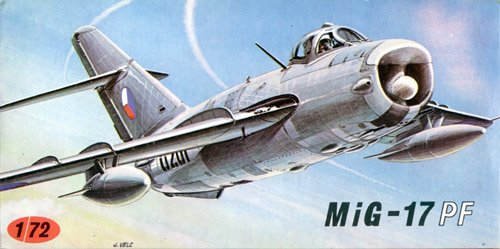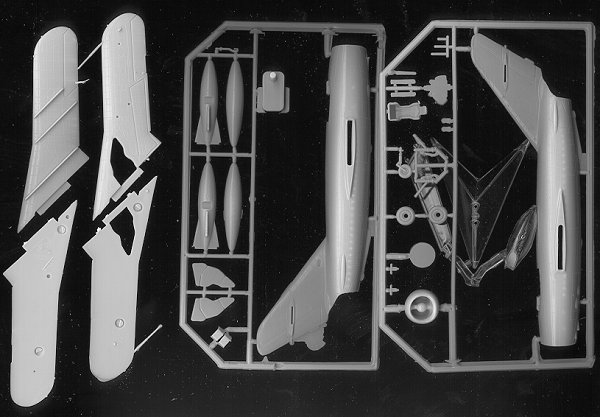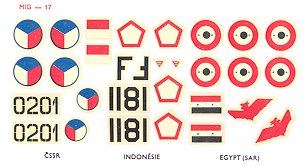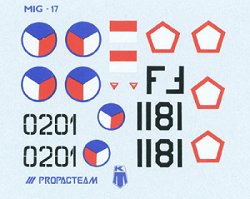
|
KIT: |
KP 1/72 MiG-17 PF |
|
KIT # |
7 |
|
PRICE: |
$8.98 MSRP currently (2003) |
|
DECALS: |
Three options |
|
REVIEWER: |
Scott Van Aken |
|
NOTES: |

|
HISTORY |
The MiG-17 was one of the Soviet Union's most successful designs. Basically a MiG-15 with an improved wing and afterburning engine, the MiG-17 went on to be widely exported. Not only Soviet Bloc countries bought the aircraft, but also many other nations who were either friendly to the USSR and its willingness to extend its influence through materiel sales, or by those who didn't have a lot of money to spend on weapons and new a good deal when they saw it.
Typical of Soviet aircraft, the MiG-17 was a delight to fly and simple to maintain. Ruggedness is a trademark of Russian-built aircraft as they were expected to operate from minimally maintained airstrips and to be maintained by semi-skilled technicians. In this respect, it was a huge success and these traits ensured that many airframes would survive to become warbirds in the hands of wealthy enthusiasts.
Like other Soviet designs, it was also manufactured in some Warsaw Pact countries. Both Poland and Czechoslovakia have long histories of aviation manufacture and these countries as well as China produced the MiG-17. It is mostly these planes rather than Russian-manufactured aircraft that have survived.
|
THE KIT |

There was a time, back about 30 years ago, when if you wanted a model of a Soviet aircraft, you had to turn to KP for the kit. KP has had a long tradition of producing models of aircraft that have served in the Czech Air Force. They also produce remarkably accurate models. Their MiG-17 is no exception as it is still considered by many to be the most dimensionally accurate MiG-17 kit on the market. This kit represents the radar-nosed version with guns and not the most commonly built Mig-17F.
However, it is a product of the old school of kit engineering. The detail is rivets and raised panel lines (save for controls). The grey plastic holds detail well though in some cases this detail is a bit on the 'soft' side. There is some flash and some kits show rather prominent ejector pin stubs, though this one was relatively free from them. Sink marks are to be found opposite alignment pins and slots in some areas. Other than drop tanks, there are no options.
The cockpit is well detailed for a kit of this time with instruments represented by raised detail. There is a seat, tub, control stick and rudder pedals included. The wheels can be made to roll on the main gear by using a hot blade to flatten the axle once the wheel's been inserted. As with all KP kits, it comes with a clear display stand.
 Instructions
are quite good with several exploded views for the construction steps. A
set of drawings is provided so that you can be sure you have the parts
properly aligned, something that I wish some other
Instructions
are quite good with several exploded views for the construction steps. A
set of drawings is provided so that you can be sure you have the parts
properly aligned, something that I wish some other
 companies provided.
The instructions for my kit were in English, though I have bought other KP kits which had them in Czech. Markings are for three planes. Czech and
Indonesian aircraft are in bare metal while the Egyptian version is in a
desert camouflage. Decals by this time have deteriorated quite a bit, but
when new were not bad at all.
companies provided.
The instructions for my kit were in English, though I have bought other KP kits which had them in Czech. Markings are for three planes. Czech and
Indonesian aircraft are in bare metal while the Egyptian version is in a
desert camouflage. Decals by this time have deteriorated quite a bit, but
when new were not bad at all.
Late Note: Thanks to one of our readers, I've learned that the new releases of these kits all have Propagteam decals. A huge difference and one that will really help. Here's a shot of a partial newer sheet. Thanks for the info and the new box top picture, Gordon!
|
CONCLUSIONS |
I must confess that every KP kit I've built has not had perfect fit and filler has destroyed a lot of the detail along the seams. I tend to treat them as very good short run kits. However, they all have been nice models when they were finished and are still among the most accurate representations of their subjects that you can find.
If you would like your product reviewed fairly and quickly by a site that has nearly 250,000 visitors a month, please contact me or see other details in the Note to Contributors.